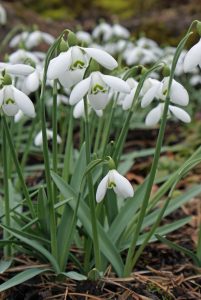February in the garden
The snowdrop and primrose our woodlands adorn, The violets bathe in the wet o' the morn Robert Burns
February is snowdrop month and with it, comes the anticipation of spring. Gardeners are eternal optimists, as we are always looking forward while actively engaging in the present. And that optimism and hope that things will be better this year is so important to the human condition, especially after the last year we’ve all been through. It’s no coincidence then that one common name for the snowdrop is the flower of hope.
The snowdrop Galanthus nivalis, is so familiar that it’s a surprise to find out that it’s actually not a native plant, originating in mainland Europe. It’s not known when it was introduced, but they were first recorded in the wild in the late eighteenth century. As they flower so early, snowdrops do not rely on pollinators to reproduce. However, bees and other insects may visit their flowers on warm, sunny days.

Best seen en-masse in a woodland, snowdrops also work well in clumps in gardens. The best time to propagate snowdrops is when they have finished flowering, but are still in leaf (“in the green”). Divide up the clumps using a hand fork and re-plant. If you don’t have enough space in your own garden, consider giving some to a friend or neighbour. After all, who can resist snowdrops?
February does not let go of winter’s grip easily, and that dictates what can and cannot be done in the garden. If not already done, ground should be prepared for this year’s vegetable and salad crops to be grown. This could be digging in compost (or other organic material), or if you prefer the no-dig method, simply spread compost on top of the soil. This allows earthworms and thrushes to do your digging for you. The no-dig method works best in narrow (1.2m wide) beds, as it’s important not to trample on the soil.
When the weather is less kind for gardening, seed catalogues provide a feast for your eyes and imagination. “What are you growing this year?” is a great opening question for all gardeners. Seed sowing is one of the most satisfying jobs you can do as a gardener, and it still fills me with boyish enthusiasm, countless years after sowing my first seeds. The process of bringing these dry, organic materials to life, through the process of sowing them into compost, watering them and nurturing them is the closest thing to magic that we have on planet earth. It’s no small thing that as we look after the seeds and later, plants, we are also enriching our own lives, giving ourselves a sense of purpose; a responsibility to continue to look after these new lives; and satisfaction in seeing them grow and prosper. It’s easy to see why gardening is the perfect tonic for our mental health and well-being. Happy gardening!
This blog was first published in The Crieff and Comrie Quair, February 2021

Recent Comments